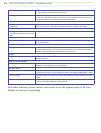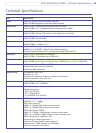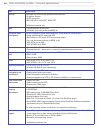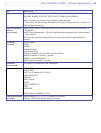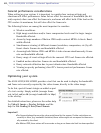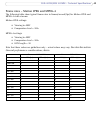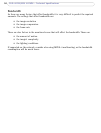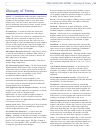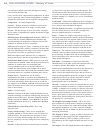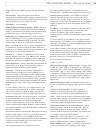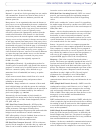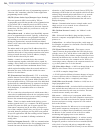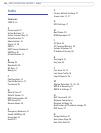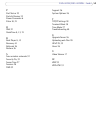
55
AXIS 207W/AXIS 207MW - Glossary of Terms
progressive scan. See also Interlacing.
Protocol - A special set of rules governing how two entities
will communicate. Protocols are found at many levels of
communication, and there are hardware protocols and
software protocols.
Proxy server - In an organisation that uses the Internet, a
proxy server acts as an intermediary between a workstation
user and the Internet. This provides security, administrative
control, and a caching service. Any proxy server associated
with a gateway server, or part of a gateway server,
effectively separates the organisation’s network from the
outside network and the local firewall. It is the firewall
server that protects the network against outside intrusion.
A proxy server receives requests for Internet services (such
as web page requests) from many users. If the proxy server
is also a cache server, it looks in its local cache of previously
downloaded web pages. If it finds the page, it is returned to
the user without forwarding the request to the Internet. If
the page is not in the cache, the proxy server, acting as a
client on behalf of the user, uses one of its own IP addresses
to request the page from another server over the Internet.
When the requested page is returned, the proxy server
forwards it to the user that originally requested it.
P-VOP - See VOP.
QoS (Quality of Service) - By marking data packets for
various types of network traffic, QoS provides the means to
guarantee a certain level of a specified resource to selected
traffic on a network. Quality can be defined as e.g. a
maintained level of bandwidth, low latency, no packet
losses, etc.
A QoS-aware network allows critical flows to be served
before flows with lesser priority and promotes better
reliability in the network.
Resolution - Image resolution is a measure of how much
detail a digital image can hold: the greater the resolution,
the greater the level of detail. Resolution can be specified as
the number of pixel-columns (width) by the number of
pixel-rows (height), e.g. 320x240.
Alternatively, the total number of pixels (usually in
megapixels) in the image can be used. In analog systems it
is also common to use other format designations, such as
CIF, QCIF, 4CIF, etc.
RTCP (Real-Time Control Protocol) - RTCP provides
support for real-time conferencing of groups of any size
within an intranet. This support includes source
identification and support for gateways like audio and video
bridges as well as multicast-to-unicast translators.
RTCP offers quality-of-service feedback from receivers to
the multicast group as well as support for the
synchronization of different media streams.
RTP (Real-Time Transport Protocol) - RTP is an Internet
protocol for the transport of real-time data, e.g. audio and
video. It can be used for media-on-demand as well as
interactive services such as Internet telephony.
RTSP (Real Time Streaming Protocol) - RTSP is a control
protocol, and a starting point for negotiating transports
such as RTP, multicast and Unicast, and for negotiating
codecs.
RTSP can be considered a "remote control" for controlling
the media stream delivered by a media server. RTSP servers
typically use RTP as the protocol for the actual transport of
audio/video data.
Router - A device that determines the next network point to
which a packet should be forwarded on its way to its final
destination. A router creates and/or maintains a special
routing table that stores information on how best to reach
certain destinations. A router is sometimes included as part
of a network switch. See also switch.
Server - In general, a server is a computer program that
provides services to other computer programs in the same or
other computers. A computer running a server program is
also frequently referred to as a server. In practice, the server
may contain any number of server and client programs. A
web server is the computer program that supplies the
requested HTML pages or files to the client (browser).
Sharpness - This is the control of fine detail within a
picture. This feature was originally introduced into color TV
sets that used notch filter decoders. This filter took away all
high frequency detail in the black and white region of the
picture. The sharpness control attempted to put some of that
detail back in the picture. Sharpness controls are mostly
superfluous in today's high-end TVs. The only logical
requirement for it nowadays is on a VHS machine.
Simplex - In simplex operation, a network cable or
communications channel can only send information in one
direction.
SMTP (Simple Mail Transfer Protocol) - SMTP is used for
sending and receiving e-mail. However, as it is "simple," it
is limited in its ability to queue messages at the receiving
end, and is usually used with one of two other protocols,
POP3 or IMAP. These other protocols allow the user to save
messages in a server mailbox and download them
periodically from the server.
SMTP authentication is an extension of SMTP, whereby the
client is required to log into the mail server before or during
the sending of email. It can be used to allow legitimate users
to send email while denying the service to unauthorized
users, such as spammers.
SNMP (Simple Network Management Protocol) - SNMP
forms part of the Internet Protocol suite, as defined by the
Internet Engineering Task Force. The protocol can support
monitoring of network-attached devices for any conditions
that warrant administrative attention.
Sockets - Sockets are a method for communication between
a client program and a server program over a network. A
socket is defined as "the endpoint in a connection." Sockets



